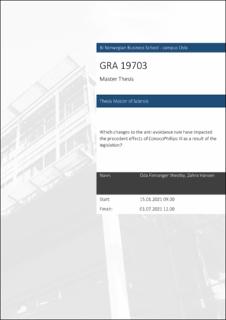| dc.description.abstract | This master thesis has aimed to gain an understanding of how the enactment of
the general anti-avoidance rule in the Tax Act has affected Norwegian
taxpayers. To do so, we have dissected elements from Rt-2014-227, also
known as ConocoPhillips III, to exemplify which changes the legislation brings
with it. We have chosen this case because its precedent effects created
uncertainty in the tax world, where a demerger conducted almost
simultaneously to selling immovable property in the form of shares became
accepted practice.
Our interest in tax avoidance was prompted by the legislation itself, as we
wanted to write about current affairs in the tax world. Part I includes a
presentation of the topic and the thesis structure. Part II, analysis, starts off
with a review of ConocoPhillips III and an examination of the changes to the
general anti-avoidance rule as a result of the legislation, as well as an
assessment of the relationship between the legislated anti-avoidance rule and
ConocoPhillips III, with a conclusion of where the law currently stands.
Furthermore, part II includes an analysis of arguments from the case that speak
both for and against tax avoidance, where we have made conclusions as to
whether the legislated anti-avoidance rule has had any impact on predictability
for taxpayers, their need for legal expertise, the threshold for counteraction and
if the time between demerging and selling shares is a factor that has lost its
value. Our findings show that the precedent effects of the case have not
changed as a result of the legislation, although the Ministry of Finance’s
interpretation of the anti-avoidance bill created a plethora of uncertainty
regarding whether the transaction chain in the case would remain accepted
practice within the bounds of legal tax planning.
Lastly, we have included three additional components; an assessment of
whether the outcome of the case would be different after the legislation, the
ethical and socio-economic consequences of the legislation, and whether the
rule is in conflict with any international law. | en_US |
